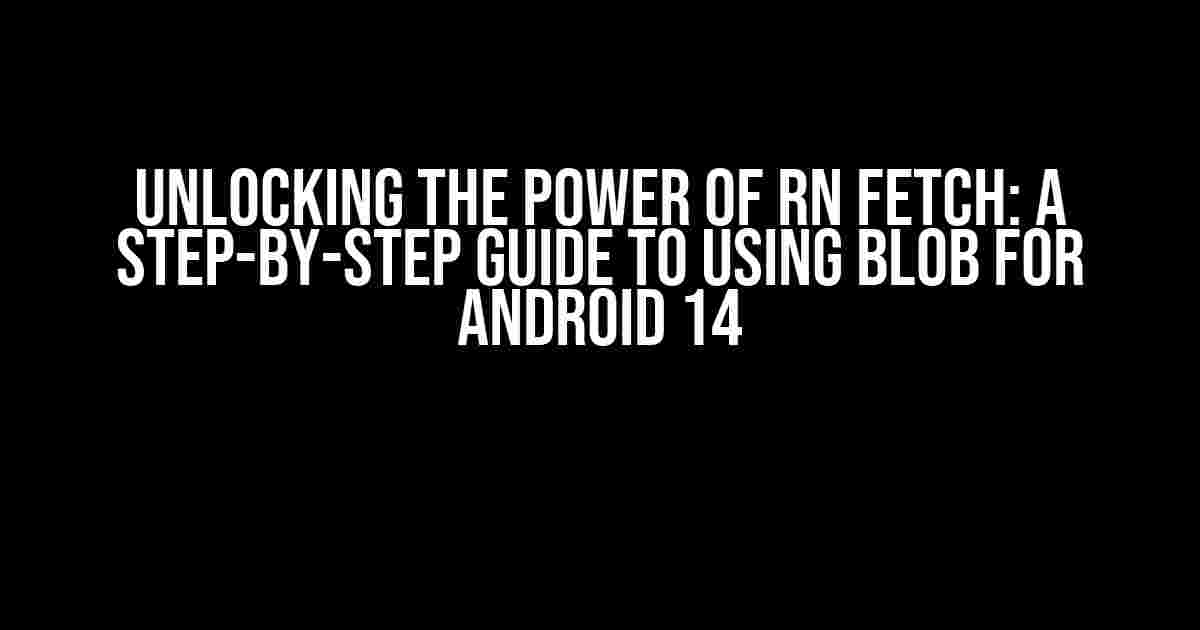Are you tired of dealing with the limitations of traditional HTTP requests in your React Native app? Do you want to take your app to the next level by leveraging the power of Blobs? Look no further! In this comprehensive guide, we’ll show you how to use RN Fetch to work with Blobs on Android 14, empowering you to build faster, more efficient, and more scalable apps.
What are Blobs and Why Do You Need Them?
A Blob (Binary Large OBject) is a collection of binary data stored as a single entity. In the context of React Native, Blobs are used to represent large files, such as images, videos, and audio files, which can be stored and manipulated locally on the device.
The benefits of using Blobs are numerous:
- Reduced network overhead: By storing files locally, you can reduce the amount of data transferred over the network, resulting in faster app performance and lower bandwidth costs.
- Improved security: Blobs allow you to store sensitive data securely on the device, reducing the risk of data breaches.
- Enhanced user experience: With Blobs, you can provide a seamless user experience by caching frequently accessed files, reducing latency, and improving overall app responsiveness.
Introducing RN Fetch: The Ultimate Blob Management Tool
RN Fetch is a powerful library that provides a simple, intuitive API for working with Blobs in React Native. With RN Fetch, you can easily fetch, store, and manipulate Blobs, giving you the flexibility and control you need to build high-performance apps.
Why Choose RN Fetch?
RN Fetch offers a range of benefits, including:
- Simple API: RN Fetch provides a straightforward, easy-to-use API that makes it easy to work with Blobs.
- Flexible caching: RN Fetch allows you to customize caching behavior to suit your app’s specific needs.
- Robust error handling: RN Fetch provides comprehensive error handling, ensuring that your app remains stable and responsive even in the face of errors.
Setting Up RN Fetch for Android 14
To get started with RN Fetch, follow these simple steps:
- Install RN Fetch using npm or yarn:
- Import RN Fetch in your React Native component:
- Initialize RN Fetch with the required configurations:
npm install rn-fetch or yarn add rn-fetch
import RNFetch from 'rn-fetch';
const { fetch, Blob } = RNFetch({
// Configure caching behavior
cache: {
enabled: true,
maxAge: 3600000, // 1 hour
},
});
Working with Blobs using RN Fetch
Now that you’ve set up RN Fetch, it’s time to start working with Blobs! Here are some examples of how to use RN Fetch to fetch, store, and manipulate Blobs:
Fething a Blob
To fetch a Blob using RN Fetch, use the `fetch()` method:
const url = 'https://example.com/image.jpg';
const blob = await fetch(url, {
method: 'GET',
headers: {
Accept: 'image/jpeg',
},
});
Storing a Blob Locally
To store a Blob locally using RN Fetch, use the `Blob` constructor:
const blob = new Blob(['Hello, World!'], { type: 'text/plain' });
await blob.writeToFile('file.txt', 'utf8');
Reading a Blob from Storage
To read a Blob from storage using RN Fetch, use the `readFromFile()` method:
const blob = await Blob.readFromFile('file.txt', 'utf8');
const text = await blob.text();
console.log(text); // Output: "Hello, World!"
Troubleshooting Common Issues
As with any powerful library, RN Fetch is not immune to issues. Here are some common troubleshooting tips to help you overcome common challenges:
| Issue | Solution |
|---|---|
| Network request failed | Check your network connection and ensure that the URL is correct. |
| Cache not working | Verify that caching is enabled and configured correctly. |
| Blob not stored locally | Check that the file path is correct and that the device has sufficient storage space. |
Best Practices for Using RN Fetch with Android 14
To get the most out of RN Fetch with Android 14, follow these best practices:
- Use caching wisely: Implement caching to reduce network requests and improve app performance, but be mindful of storage constraints.
- Optimize file sizes: Compress files to reduce storage space and improve app performance.
- Handle errors gracefully: Use try-catch blocks to handle errors and provide a seamless user experience.
Conclusion
In this comprehensive guide, we’ve shown you how to unlock the power of RN Fetch to work with Blobs on Android 14. By following these step-by-step instructions and best practices, you’ll be well on your way to building high-performance, scalable apps that take advantage of the latest React Native features.
Remember to stay up-to-date with the latest RN Fetch releases and React Native updates to ensure that your app remains optimized and secure. Happy coding!
Frequently Asked Question
Got questions about RN Fetch blob for Android 14? We’ve got answers!
What is RN Fetch blob and why do I need it for Android 14?
RN Fetch blob is a library that allows you to fetch and manipulate blob data in your React Native app. With Android 14, Google introduced a new security feature that restricts apps from accessing the file system directly. RN Fetch blob helps you comply with this new security policy by providing a secure way to handle blob data in your app.
How do I integrate RN Fetch blob into my React Native app for Android 14?
To integrate RN Fetch blob, you’ll need to install the library using npm or yarn, then import it into your React Native component. From there, you can use the library’s API to fetch and manipulate blob data in your app. Be sure to follow the official documentation for detailed installation and usage instructions.
What are some common use cases for RN Fetch blob in Android 14 apps?
RN Fetch blob is perfect for apps that need to handle large files, such as image and video editing apps, file managers, and cloud storage integrations. It’s also useful for apps that require secure data encryption, like password managers and financial apps. Any app that needs to deal with binary data can benefit from RN Fetch blob!
Is RN Fetch blob compatible with other React Native libraries and frameworks?
Yes, RN Fetch blob is designed to work seamlessly with other popular React Native libraries and frameworks, such as Expo, React Navigation, and Redux. It’s built to be modular and flexible, so you can integrate it into your existing app architecture with ease.
How does RN Fetch blob ensure the security and integrity of my app’s data?
RN Fetch blob takes data security seriously! It uses a combination of encryption, secure storage, and access controls to protect your app’s data. The library also provides features like data validation and error handling to ensure that your app remains stable and secure, even in the face of unexpected errors or malicious attacks.





